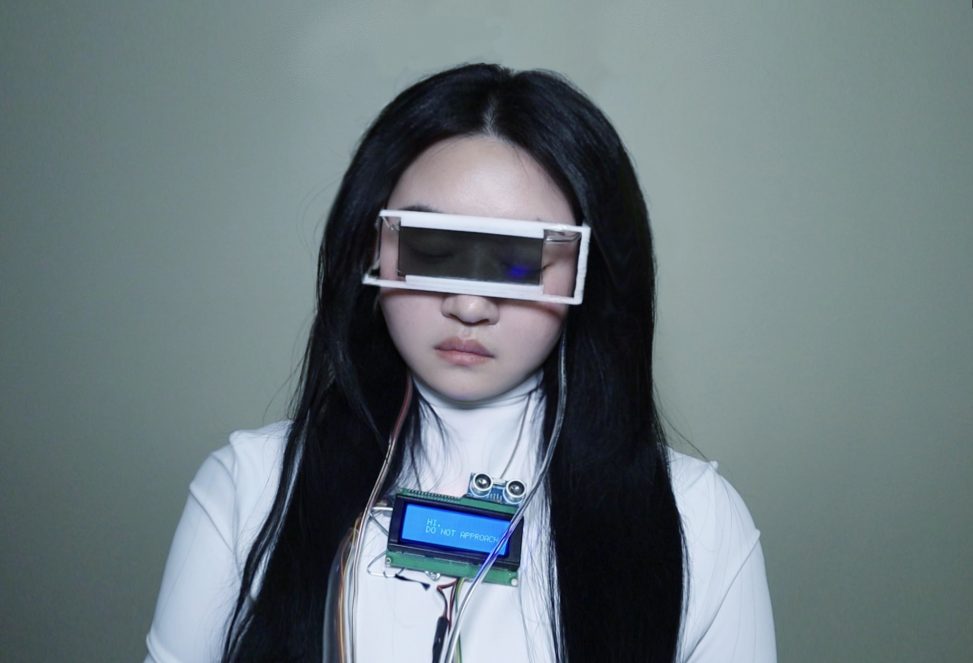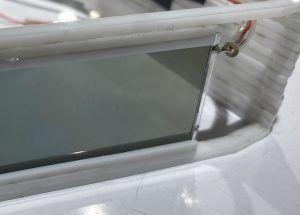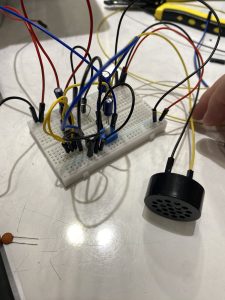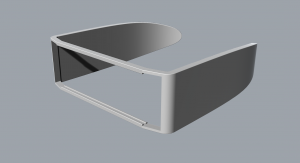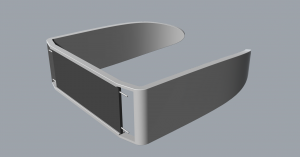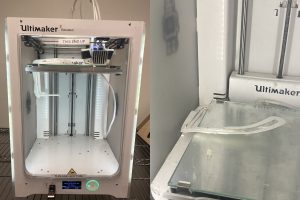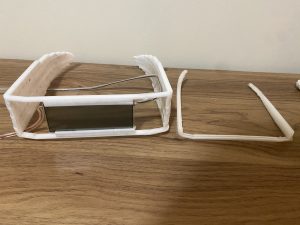Description
This is a wearable piece that includes a pair of glasses that can change the opacity of the lens and a little installation that can be attached to clothes and will display text and make sounds when the sensor senses things within its range.
Overview
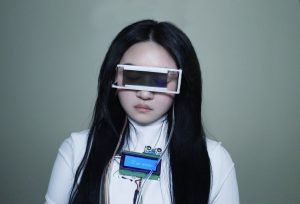 The lens is transparent when there is no one within 50 cm;
The lens is transparent when there is no one within 50 cm;
and the LCD screen displays”Hi. Do not approach”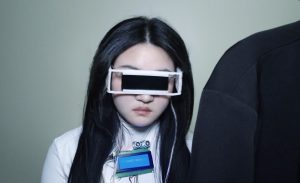 The lens becomes dark when someone is standing within 50 cm;
The lens becomes dark when someone is standing within 50 cm;
and the LCD screen displays “!!!STEP BACK!!!”
Simulation of you walking up to a person wearing this device
This is a jacket on a hanger. The glasses’ lens will become dark when the distance is within 50cm, just like what happens in the photo above.
The overall device. (I don’t have anyone with me, so I have to put it on a table and record this. )
Detail of the device:
The glass frame has an angle and a rail that allows me to slide the lens in simply if I need to change the lens.
Background
This is an assistive device for me.
First, it’s about social distance. I feel that the term “social distance” was used everywhere during the pandemic. During that time, most of us were used to keeping our distance from others. But as we are now in the post-pandemic era, I don’t see a lot of people still maintaining social distance now. However, I still like to keep a certain distance from other humans in social situations. I also sometimes find it difficult to interact with people at a close distance, especially at social events.
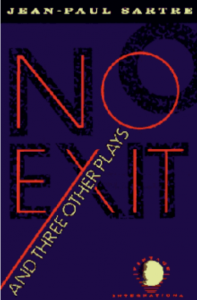
The reason is probably that I read a novel called “No Exit” by Jean-Paul Sartre, a French playwright. He proposed a derived philosophical theory called “others are hell.” This sentence doesn’t mean that other people are the devil. It means that everyone is free without others’ intervention. In the book, Sartre describes four people whose souls have fallen into hell. There is no torture or fire as expected, but only a closed chamber that locks the four people so that whatever they do has to be done in the presence of others. The lights are always on, and the knife cannot kill other people. Sartre considered such to be the suffering of hell. My understanding is that in such a situation, the gaze of others can influence my free will, shape my choices and cause me pain, especially when I sometimes make choices against my will under the influence of others. I see other people as people that are “not me.” In this case, the difference between “me” and “others” defines the scope of “self.” So, without others, I would not be the person I am now, but the person I am now is in danger of losing my ability to judge and choose freely because of others.
To put it in perspective of vision, human vision is more than simply looking at things. When I look at the outside world as an individual, the world comes together towards me, hence, I am the center of the world, and I am completely free. This gives rise to a transcendence, meaning that I am subjective, which is also called the ‘subject self’ by Sartre. But when in groups or in public, all my activities will be branded with the shadow of others, and I will find myself gazed at by others. I then will degenerate under the gaze of others because I take the gaze of others as my own possibility in my activity. This is also an alienation, an objectification, and a deprivation of freedom and transcendence as a subject. Thus the ‘subject me’ becomes the ‘object me,’ and the OTHERS become the subject in my eyes. The “my world” built up by my perspective collapses, and this is the so-called “other is hell.”
If we reflect this theory into reality, I think people become “objects” when they interact with each other in any form, for example, eye contact or conversation. I don’t want to lose my subjective self in social and public events, so I thought of making this device. Basically, there is an ultrasonic ranger on the installation that can be attached to clothing. This is to sense the distance. When no one is in my social comfort zone (50cm), the lens of the glasses (light valve) is clear, like normal light-colored indoor sunglasses, and the LCD screen will display “Hi. Do not approach”. But when someone steps into my social comfort zone, the lenses of the glasses will darken, basically impossible to see through, and the device that is attached to the clothing will start going on an alarm. The text on the screen will change to a flashing “!!! STEP BACK!!!”. This device is also an artificial social shield for me.
Process
Decision 1:
I spent a lot of time thinking and experimenting with two kinds of sounds for a ‘warning sound.’
- Use a buzzer. This will create a sound that really sounds like a warning. but people may wonder if there’s anything bad happening.
- 2. Use a speaker that plays my own voice saying “Step back.” This fits my ideation more; however, as I tested it with my friends, I got feedback like “I heard Angie’s voice, so I want to come closer.” This totally contradicts my intention. But I found it interesting that sometimes the result will be different from my ideation until I really experiment with my design with people.
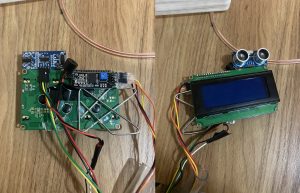 I finally decided to use the buzzer because it is small so it can be glued to the back of the screen together with the ultrasonic ranger. Most importantly, it turns out to be less attractive than using my own voice.
I finally decided to use the buzzer because it is small so it can be glued to the back of the screen together with the ultrasonic ranger. Most importantly, it turns out to be less attractive than using my own voice.
Decision 2:
For the glasses’ frame, I want it to have a futuristic look like the 3D model I made, ideally.
The modeling process took a very long time because this was my first time using Rhino to build a 3D model.
I initially wanted to use 3D printing because the nylon material is more suitable for a wearable device since it can bend a little. However, the 3D printer failed my printing several times, and almost 20 hours were wasted.
These are pictures of the first and second time of printing failures.
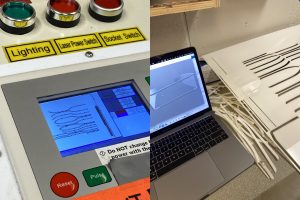 So, Cody suggested and helped me a lot to use the laser cutter instead. Since I have never used a laser cutter before, I also spent time learning how to operate the machine and put the parts together.
So, Cody suggested and helped me a lot to use the laser cutter instead. Since I have never used a laser cutter before, I also spent time learning how to operate the machine and put the parts together.
But the dimension of my model is wrong when the software automatically converts the 3D model to the slices. The original dimension of the frame should exactly fit my head. And the failed 3D printing actually fits according to my original dimension. However, the laser-cut pieces turned out to be much bigger than the dimensions I set. This also resulted in I had to hold the glasses during the showcase. The frame on the right is the 3D printing (third failed version), and the one much bigger on the left is the laser cutting version.
Discussion
I prefer to call it my work rather than a project. The idea of my creation has always been to do something meaningful. For example, this work combines the philosophical theory of Sartre while curing my fear of social interaction. So in a macro sense, I am satisfied with it.And I like the process of me brainstorming about things.For example, the futuristic glasses reminded me of my other work about bionic robots. So when I was finishing the wiring, I thought of wrapping the wires with soft pipes. This not only solves the problem of messy wiring but also leads me to think about another possibility: what if a bionic robot were to wear the device? Can these wires be plugged directly into its body? Maybe this can be a way to train it to learn and ‘feel’ like a real person, a person that has problems socializing with other people.
However, there are still some regrets about this work, such as the fabrication part. In fact, the final version of laser cutting is not quite what I wanted in mind. And the size of the cut is not the same as the one I measured, so the work is not perfect. But anyway, I think this is a good start, and I am grateful for everyone’s help. I have never used laser cutters and 3D printers before, so I learned a lot of skills from quick learning and operation this time.
I also received a lot of meaningful feedback. One is about the choice of sound that the device would make when people are getting closer. This is also one of the most tangled questions during the process. It is interesting to hear that different people have different suggestions and preferences on sounds choice. Some say that they would be attracted more by the buzzer sound, while some say they definitely will come closer and take a look if it is displaying a sound of me or a robot. I think this is something associated with psychology and sociology. I definitely would dig into related research and see which way may fit my concept better. Another interesting piece of feedback is from one of the faculties. He commented that maybe it would be better to create a device that could make me invisible in public places. But I thought about it for a long time, and I think that this is not the best solution for me. I think my main point is to avoid social interactions that make me uncomfortable, like getting too close, rather than hiding myself completely. When others step into my comfort zone, even if I don’t want to be forced to be an “object, I am physically present in the world, so I have no right to prevent anyone from gazing at me or interacting with me. This is their freedom. All I can do is shield myself and avoid interactions. After all, all I want is to remain my own self when socializing, and perhaps choosing to avoid unnecessary interactions is also a manifestation of the subjective self.
Technical information
Block Diagram:
Schematic Diagram:
Code
// My Social Shield
// Angie (Chuyi) Wang
// This code allows you to make a sound with a buzzer, display different texts on an LCD screen and control the transparency of
// a light valve while the ultra sonic ranger detects the distance.
//For the light valve, one wire goes to the GND and another wire must be connected to analog pin. (I used A0)
// References: https://courses.ideate.cmu.edu/60-223/s2023/tutorials/I2C-lcd
// https://www.instructables.com/How-to-use-a-Buzzer-Arduino-Tutorial/
#include <Wire.h>
#include <LiquidCrystal_I2C.h>
#define trigPin 10
#define echoPin 13
#define LIGHTVALVE A0
int brightness = 0;
int fadeAmount = 5;
const int buzzer = 7; //buzzer to arduino pin 7
long transparency;
// Set the LCD address to 0x27 for a 20 chars and 4 line display
LiquidCrystal_I2C lcd(0x27, 20, 4);
void setup() {
Serial.begin (9600);
pinMode(trigPin, OUTPUT);
pinMode(echoPin, INPUT);
pinMode(buzzer, OUTPUT); // Set buzzer - pin 7 as an output
pinMode(LIGHTVALVE, brightness);
lcd.init();
lcd.begin(10,2);
}
void loop() {
float duration, distance;
digitalWrite(trigPin, LOW);
delayMicroseconds(2);
digitalWrite(trigPin, HIGH);
delayMicroseconds(10);
digitalWrite(trigPin, LOW);
duration = pulseIn(echoPin, HIGH);
distance = (duration / 2) * 0.0344;
int d1 = distance;
// mapping the distance to brightness
if(d1 > 90){
d1 = 90;
}
// analogWrite(LIGHTVALVE , brightness);
brightness = map(d1, 0, 90, 255,0);
analogWrite(LIGHTVALVE,brightness);
lcd.clear();
// delay(100);
if (distance >= 50 || distance <= 2){
Serial.print("Distance = ");
Serial.println("Out of range");
// Serial.println(distance);
//panelState = 0;
brightness = 0;
// delay(1000);
//analogWrite(d1 , LIGHTVALVE);
// Turn on the blacklight and print a message.
lcd.backlight();
lcd.setCursor(4,1);
lcd.print("HI.");
lcd.setCursor(4,2);
lcd.print("DO NOT APPROACH.");
delay(500);
}
else {
lcd.backlight();
lcd.setCursor(1, 5);
// lcd.clear();
lcd.print(" !!!STEP BACK!!!");
//print distance to serial
Serial.print("Distance = ");
Serial.print(distance);
Serial.println(" cm");
delay(200);
//Buzzer
tone(buzzer, 1000); // Send 1KHz sound signal...
delay(500); // ...for 1 sec
noTone(buzzer); // Stop sound...
delay(200); // ...for 1sec
//change the transparency
// analogWrite(LIGHTVALVE , brightness);
brightness = brightness + fadeAmount;
}
}
